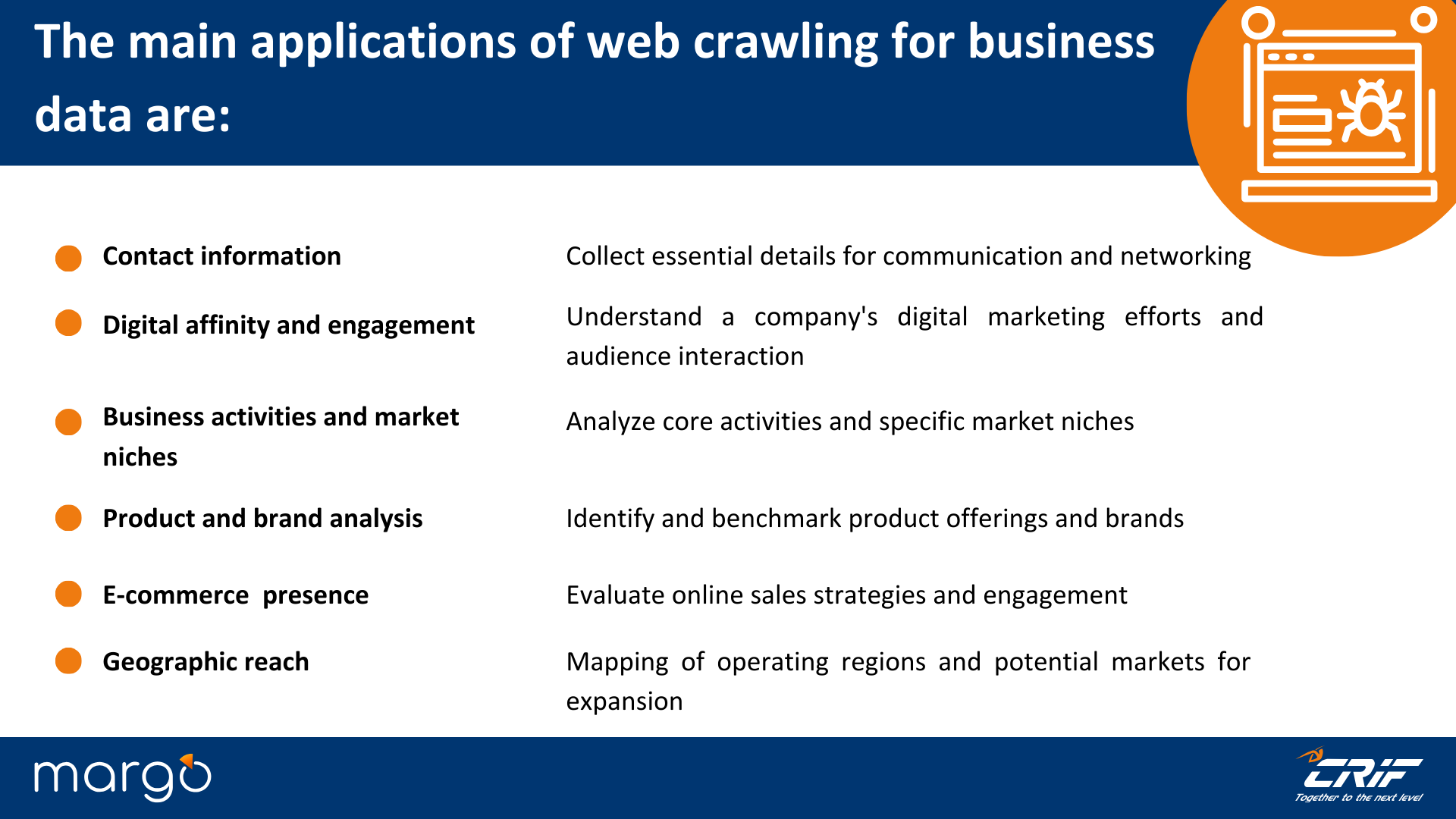
Web crawling: a new way to collect data
Web crawling is a powerful technique for collecting B2B company data. This technology enhances your access to information by leveraging content available on corporate web pages. Such a source not only adds value to your business but also provides invaluable insights into competitors, market trends, and potential opportunities.
Let's take a closer look.
What is web crawling?
Crawling is the process where search engines, such as Google, explore and analyze the web page using software called web crawlers or spiders that constantly understand the content and structure of a website.
Because Spiders move around the network or World Wide Web, they access sites via the Internet and collect information on each page, including titles, images, keywords and links. Mainly used to index search engine pages, web crawlers are used also to gather or search for data, extract content from websites, monitor changes and comparison.
Applications of web crawling for business data
The content of a company's website offers a window into its activities and services, as well as product brands managed. By analyzing this data, businesses can gain a deeper understanding of market dynamics and competitive strategies.
Web crawlers are also able to collect essential B2B contact information such as email addresses, phone numbers and physical addresses. This data are useful for data quality, networking, sales outreach and building business partnerships.
A company's digital footprint, including links to social media, blogs and other online activities, reveals much about its digital marketing strategies and audience engagement levels. This information is vital for creating effective marketing campaigns and understanding competitors' strategies.
Crawling product pages and catalogs help identify the types of business activity, products and brands a company sells. This is particularly useful for market research and competitive analysis, allowing businesses to compare their offerings with those of competitors.
It is also possible to obtain information about a company's own e-commerce platforms. Indeed, the presence or absence of e-commerce functionality on websites provides information on the sales strategies and online commitment of a company.
To identify potential markets for expansion, web crawlers can also gather information on the countries in which a company operates and map its own and its competitors' geographical reach.
In brief, the main applications of web crawling for business data are:
- Contact information: collect essential details for communication and networking
- Digital affinity and engagement: understand a company's digital marketing efforts and audience interaction
- Business activities and market niches: analyse core activities and specific market niches
- Product and brand analysis: Identify and benchmark product offerings and brands
- E-commerce presence: evaluate online sales strategies and engagement
- Geographic reach: mapping of operating regions and potential markets for expansion

Web crawling data can be integrated with Trade Register data
As mentioned earlier, web crawling is a powerful tool for extracting business data, providing critical insights into market trends, competitive strategies, and potential opportunities.
Another advantage of web crawling for business data is that it can be integrated with official sources, such as Trade Registers, to obtain a comprehensive and up-to-date overview of a company's legal and financial situation as well as its activity status.
Marketing intelligence platforms such as CRIF Margo help users make effective use of B2B web crawling data in conjunction with Trade registers data and help companies stay ahead of the competition by providing detailed and actionable intelligence.
Developed by CRIF, Margo enhances sales and marketing bonds thanks to its reliable data from web crawling and Trade registers in the DACH regions. It supports your business growth by providing market analysis tools that assist your sales team in conducting market research on prospects to validate the lead generation process.
An innovative tool: the Margo semantic search
Margo uses the web crawling company data in its semantic search function. This allows you to search for companies by specifying the activity carried out in natural language: this helps to overcome the limitations of traditional industry classifications as it extends the search to online and social media sources, as well as official sources.
Along with the list of companies identified by the search, the system also suggests a set of keywords and synonyms that can be used to enrich the initial search with semantically similar words, thus increasing the number of companies identified.
This is where the power of company website data comes into play, providing a data-driven approach to identifying the right B2B targets. If this sounds interesting, you can discover more Margo business directory or sign up to the free trial of the Margo platform.